101. White-backed Duck Thalassornis leuconotus (Witrugeend)
Order: Anseriformes. Family: Anatidae (formerly: Dendrocygnidae). Subfamily: Thalassorninae
Description
43 cm. A mottled brown, hump-backed, large-headed diving duck. Head and neck buff but densely spotted black (darkest on crown, white spot at base of black bill, rest of upperparts rufous with dark brown barring and spots. White back is visible only in flight. Take-off is long and laboured, and in flight the feet project well beyond the short tail. In flight, upperwing-coverts dark brown with buff and white spots and bars, flight feathers pale brown with very narrow whitish tips to secondaries; underwings buff brown. Legs flesh-pink, darkening to blackish on feet. The sexes are similar.
Juvenile: darker and duller, with more black spotting on cheeks and upper neck, less distinctive barring below.
Distribution
Sub-Saharan Africa, in Southern Africa: Namibia, Botswana, Zimbabwe, South Africa, KwaZulu-Natal, Lesotho, Swaziland.
Habitat
Fresh water, typically among floating vegetation. Lakes, ponds, secluded wetlands and marshes.
Diet
The diet consists mostly of water lily bulbs and also seeds of aquatic plants.
Breeding
Both sexes build the nest which is located in a dense stand of reeds or rushes or grasses or sedges growing in the water, the vegetation is bent over to form a bowl of plant material drawn in from around the site and padded with green aquatic grass. The nest can be floating or built up on the vegetation to as high as 45 cm above water level. It is sometimes built on top of an old grebe or Red-knobbed coot nest. There is also vegetation overhanging the nest, which helps to obscure it from above. The nest itself consists of a bowl of dead or living plant material drawn in from around the site and padded with green aquatic grass. Breeding season is year-round.
The clutch consists of 4-9 eggs (1 laid per day). Both adults incubate the eggs for 29-33 days before they hatch. The female incubates at night and for a short time during the day; the male being responsible for the rest of the time. The change-over is preceded by calls, the duck usually approaching under the water.
Ducklings are able to swim, dive and feed within 20 hours of hatching.
Call
Tit-weet. Two note low-pitched whistle, rising on the second syllable.
Status
Uncommon resident.
Africa Wild Bird Book
White-backed Duck Photos
101. White-backed Duck Thalassornis leuconotus (Witrugeend)

Kruger National Park, Sable dam
Links:
Sabap2
Species Text Sabap1
NEWMAN'S VOELS VAN SA (8ste UIT)
http://books.google.de/books?id=RT8qww1 ... wn&f=false
http://books.google.de/books?id=MfrdBcK ... ck&f=false
http://wildfowl.wwt.org.uk/index.php/wi ... le/383/383

Kruger National Park, Sable dam
Links:
Sabap2
Species Text Sabap1
NEWMAN'S VOELS VAN SA (8ste UIT)
http://books.google.de/books?id=RT8qww1 ... wn&f=false
http://books.google.de/books?id=MfrdBcK ... ck&f=false
http://wildfowl.wwt.org.uk/index.php/wi ... le/383/383
- nan
- Posts: 26454
- Joined: Thu May 31, 2012 9:41 pm
- Country: Switzerland
- Location: Central Europe
- Contact:
Mute Swan
Mute Swan Cygnus olor (Witswaan)
Order: Anseriformes. Family: Anatidae
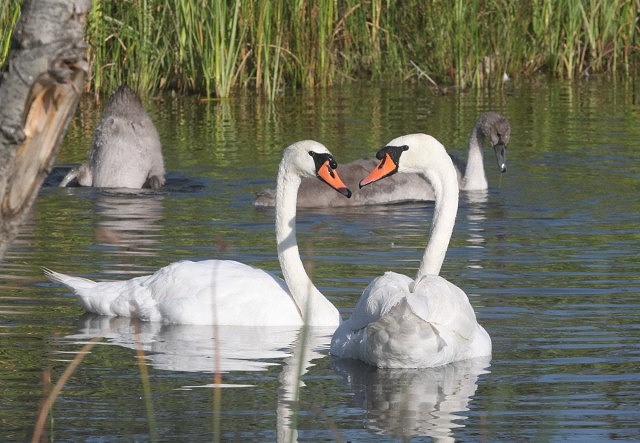
Description
Wingspan: 200-240 cm. Length: 140-160 cm. The mute swan is one of the heaviest flying birds in the world; adults can weigh over 15 kg. The combination of their large size, very long neck, white plumage and orange-red bill with a black knob towards the top of the bill makes them easily to recognise. Males (cobs) and females (pens) are similar in appearance, although males are slightly larger and have a more prominent knob on the bill. Juveniles are greyish-brown with a grey bill, which lacks the knob seen in adults.
Distribution
The mute swan is known throughout Europe and central Asia; it has also been introduced to New Zealand, Australia, South Africa, and North America.
Habitat
The mute swan is found in a wide range of water bodies, including rivers, lakes, ponds, reservoirs, flood waters, tidal estuaries, and sheltered coasts
Diet
The mute swan feeds chiefly on submerged aquatic vegetation, which is obtained by upending (tipping head first into the water, so that the tail remains visible above the surface). It also feeds in fields on young cereal crops, spilt grain.
Breeding
Pairs typically nest solitarily, although semi-domesticated birds may nest in large colonies. The cone-shaped nest is built at the edge of the water, and may be used in subsequent years by the same pair. After mid-April, between five and seven whitish or pale blue eggs are laid. They are incubated, mainly by the female, for 35 to 42 days; the young, known as 'cygnets', leave the nest soon after hatching. Both parents take care of the cygnets for an extended period, often until the next breeding season.
Call
Contrary to the name, the mute swan produces a range of vocalisations, including a rumbling heeorr, and an aggressive hissing noise when threatened.
Listen to Bird Call.
Order: Anseriformes. Family: Anatidae

Description
Wingspan: 200-240 cm. Length: 140-160 cm. The mute swan is one of the heaviest flying birds in the world; adults can weigh over 15 kg. The combination of their large size, very long neck, white plumage and orange-red bill with a black knob towards the top of the bill makes them easily to recognise. Males (cobs) and females (pens) are similar in appearance, although males are slightly larger and have a more prominent knob on the bill. Juveniles are greyish-brown with a grey bill, which lacks the knob seen in adults.
Distribution
The mute swan is known throughout Europe and central Asia; it has also been introduced to New Zealand, Australia, South Africa, and North America.
Habitat
The mute swan is found in a wide range of water bodies, including rivers, lakes, ponds, reservoirs, flood waters, tidal estuaries, and sheltered coasts
Diet
The mute swan feeds chiefly on submerged aquatic vegetation, which is obtained by upending (tipping head first into the water, so that the tail remains visible above the surface). It also feeds in fields on young cereal crops, spilt grain.
Breeding
Pairs typically nest solitarily, although semi-domesticated birds may nest in large colonies. The cone-shaped nest is built at the edge of the water, and may be used in subsequent years by the same pair. After mid-April, between five and seven whitish or pale blue eggs are laid. They are incubated, mainly by the female, for 35 to 42 days; the young, known as 'cygnets', leave the nest soon after hatching. Both parents take care of the cygnets for an extended period, often until the next breeding season.
Call
Contrary to the name, the mute swan produces a range of vocalisations, including a rumbling heeorr, and an aggressive hissing noise when threatened.
Listen to Bird Call.
- nan
- Posts: 26454
- Joined: Thu May 31, 2012 9:41 pm
- Country: Switzerland
- Location: Central Europe
- Contact:
Mute Swan Photos
Mute Swan Cygnus olor (Witswaan)
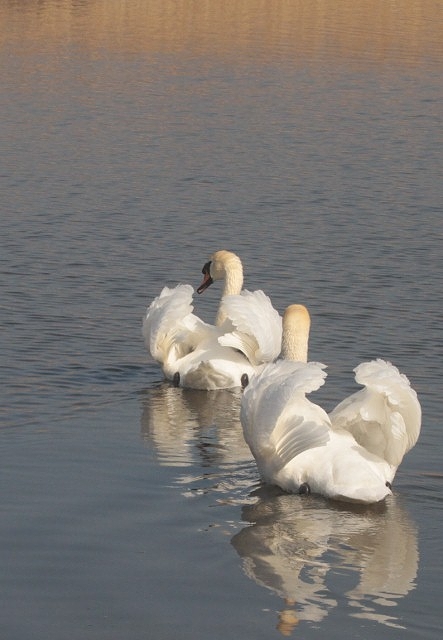
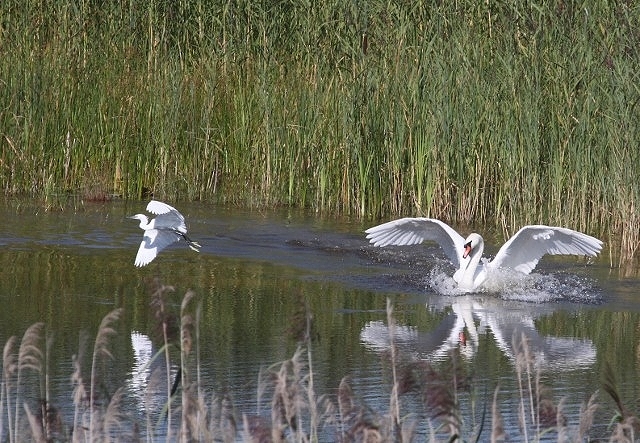
 © Flutterby
© Flutterby
Links:
Species text Sabap1: http://sabap2.adu.org.za/docs/sabap1/451.pdf
Sabap2
Ian Sinclair,P. A. R. Hockey. The Larger Illustrated Guide to Birds of Southern Africa
NEWMAN'S VOELS VAN SA (8ste UIT)


 © Flutterby
© FlutterbyLinks:
Species text Sabap1: http://sabap2.adu.org.za/docs/sabap1/451.pdf
Sabap2
Ian Sinclair,P. A. R. Hockey. The Larger Illustrated Guide to Birds of Southern Africa
NEWMAN'S VOELS VAN SA (8ste UIT)
- Flutterby
- Posts: 44029
- Joined: Sat May 19, 2012 12:28 pm
- Country: South Africa
- Location: Gauteng, South Africa
- Contact:
Spur-winged Goose
116. Spur-winged Goose Plectropterus gambensis (Wildemakou)
Order: Anseriformes. Family: Anatidae
Description
75-115 cm. A large, black goose with variable amounts of white on the throat, neck and belly.
Adult male: Plumage mostly black or blackish, with green to violet iridescence, especially on wings and back. Head and neck feathers edged brown. Face, chin and throat with varying amounts of white (some have only scattered white feathers on cheeks). White on forewing (axillaries, lesser coverts and underwing coverts), and on breast and abdomen, extending to undertail coverts. Wing with prominent carpal spur. Skin of forecrown, forehead, cheeks and eye ring usually bare. Cheek skin variably mottled emerald and turquoise. Usually has dull red frontal knob of varying size. Facial skin and knob brighter, and knob more swollen, when br. Some have small bare red or orange patch on side of upper neck. Bill deep pinkish red, nail whitish. Eyes dark brown. Legs and feet pink to deep pinkish red.
Female is duller and her facial skin is less extensive.
Juveniles are similar to adults but browner and without red facial skin.
Distribution
Found through most of the Sub-Saharan region. Widespread in southern Africa but absent to sporadic in semi-arid and arid regions in the western and north-western parts.

Habitat
Water bordered by grasslands (large rivers, floodplains, dams) and agricultural areas.
Diet
It feeds by grazing, but spends the middle part of the day resting by water. Its diet consist predominantly of plant matter such as the vegetative parts and seeds of grasses, sedges and aquatic plants, agricultural grains, fruit (e.g. figs) and tuberous crops, although it may occasionally supplement the diet with small fish or insects.
Breeding
Pair bond does not last long: male generally moves off once the young have hatched, but before this he devotes some attention to protecting the breeding territory. Nest is placed in a shallow scrape in the ground and consists of a bowl of grass, reed stems and other plant material collected by the female in the vicinity and lined with her down. The nest is usually placed in dense grass or reeds on an elevated piece of land near water. Breeding season is year-round. The female lays 7-14 eggs and on clutch completion, incubates them for 30-31 days before they hatch. Clutches of up to 27 have been recorded but these are thought to be the result of laying by more than one female. The female leaves the nest to feed in the early morning and in the late afternoon, and while she is away from the nest, she leaves the eggs covered with down to protect them and to keep them warm. Young leave the nest soon after hatching and are cared for only by the female. They fledge by about 85 days old and are able to fly soon after.
Call
Chi-chi-chi in flight.
Listen to Bird Call.
Status
Common resident; forming large flocks in non-breading season.
Order: Anseriformes. Family: Anatidae
Description
75-115 cm. A large, black goose with variable amounts of white on the throat, neck and belly.
Adult male: Plumage mostly black or blackish, with green to violet iridescence, especially on wings and back. Head and neck feathers edged brown. Face, chin and throat with varying amounts of white (some have only scattered white feathers on cheeks). White on forewing (axillaries, lesser coverts and underwing coverts), and on breast and abdomen, extending to undertail coverts. Wing with prominent carpal spur. Skin of forecrown, forehead, cheeks and eye ring usually bare. Cheek skin variably mottled emerald and turquoise. Usually has dull red frontal knob of varying size. Facial skin and knob brighter, and knob more swollen, when br. Some have small bare red or orange patch on side of upper neck. Bill deep pinkish red, nail whitish. Eyes dark brown. Legs and feet pink to deep pinkish red.
Female is duller and her facial skin is less extensive.
Juveniles are similar to adults but browner and without red facial skin.
Distribution
Found through most of the Sub-Saharan region. Widespread in southern Africa but absent to sporadic in semi-arid and arid regions in the western and north-western parts.

Habitat
Water bordered by grasslands (large rivers, floodplains, dams) and agricultural areas.
Diet
It feeds by grazing, but spends the middle part of the day resting by water. Its diet consist predominantly of plant matter such as the vegetative parts and seeds of grasses, sedges and aquatic plants, agricultural grains, fruit (e.g. figs) and tuberous crops, although it may occasionally supplement the diet with small fish or insects.
Breeding
Pair bond does not last long: male generally moves off once the young have hatched, but before this he devotes some attention to protecting the breeding territory. Nest is placed in a shallow scrape in the ground and consists of a bowl of grass, reed stems and other plant material collected by the female in the vicinity and lined with her down. The nest is usually placed in dense grass or reeds on an elevated piece of land near water. Breeding season is year-round. The female lays 7-14 eggs and on clutch completion, incubates them for 30-31 days before they hatch. Clutches of up to 27 have been recorded but these are thought to be the result of laying by more than one female. The female leaves the nest to feed in the early morning and in the late afternoon, and while she is away from the nest, she leaves the eggs covered with down to protect them and to keep them warm. Young leave the nest soon after hatching and are cared for only by the female. They fledge by about 85 days old and are able to fly soon after.
Call
Chi-chi-chi in flight.
Listen to Bird Call.
Status
Common resident; forming large flocks in non-breading season.
- Flutterby
- Posts: 44029
- Joined: Sat May 19, 2012 12:28 pm
- Country: South Africa
- Location: Gauteng, South Africa
- Contact:
Spur-winged Goose Photos
116. Spur-winged Goose Plectropterus gambensis
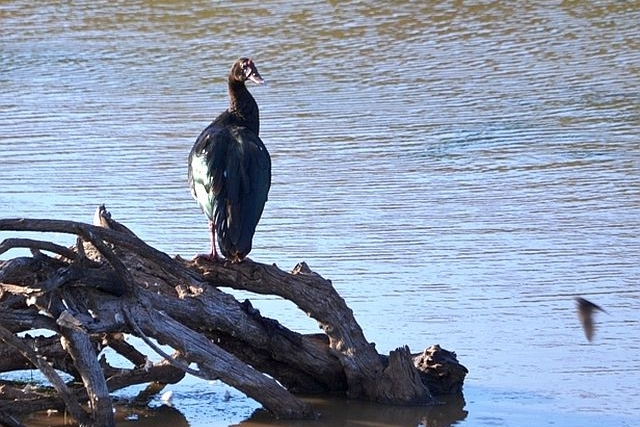 © Mel
© Mel
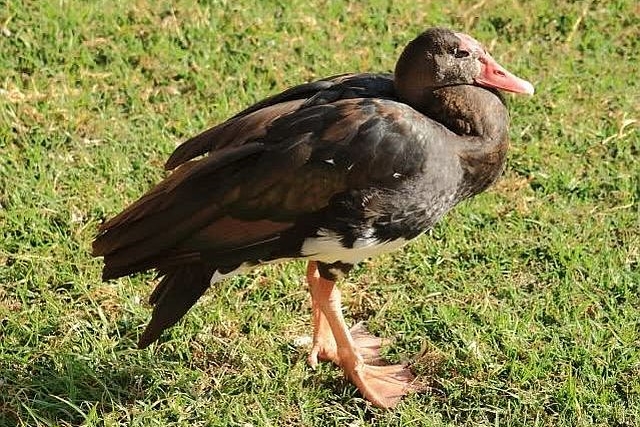 © Flutterby
© Flutterby
Juvenile
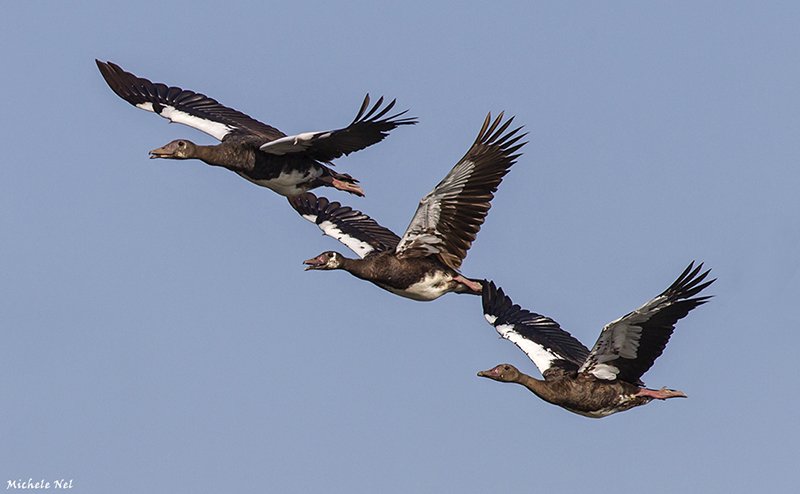 © Michele Nel
© Michele Nel
Rietvlei , Milnerton
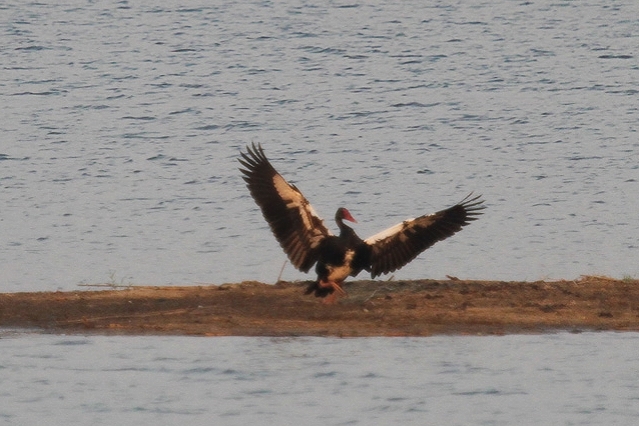 © leachy
© leachy
Kruger National Park, Sabie River Weir
 © pooky
© pooky
Adult & Juvenile, Kruger National Park, S37, Sweni Hide
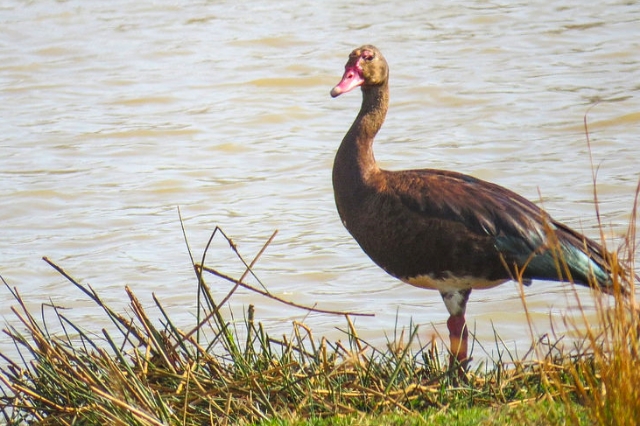 © steamtrainfan
© steamtrainfan
Pilanesberg, Malatse Dam
Links:
Species text Sabap1
Sabap2
Sasol
 © Mel
© Mel © Flutterby
© FlutterbyJuvenile
 © Michele Nel
© Michele NelRietvlei , Milnerton
 © leachy
© leachyKruger National Park, Sabie River Weir
 © pooky
© pookyAdult & Juvenile, Kruger National Park, S37, Sweni Hide
 © steamtrainfan
© steamtrainfanPilanesberg, Malatse Dam
Links:
Species text Sabap1
Sabap2
Sasol
Knob-billed Duck
115. Knob-billed Duck (formerly known as Comb Duck) Sarkidiornis melanotos (Knobbeleend)
Order: Anseriformes. Family: Anatidae
Description
Size 64-79 cm. The duck gets its common name from the large, fleshy, dark grey ‘comb’ on the top of the male’s black beak, which enlarges during the breeding season. Males have glossy blue-black or green-black upperparts, tail and wings, white underparts and pale grey or black flanks. The top of the head and back of the neck are black, and the rest of the head is white, speckled black, with yellow tinges on the sides and on the neck during the breeding season. Narrow black bands run along the sides of the upper breast. The Comb Duck’s legs and feet are dark grey, and the eyes dark brown.
Females are much smaller than males, with less glossy plumage, less well-defined black breast bands, more speckling on the head, which lacks any yellowish tinge, and sometimes with brownish mottling on the underparts. Females also lack the ‘comb’ and have a grey bill.
Juveniles are brownish, with a dark eye-stripe, and attain adult plumage in the second year.
Taxonomy
Initially, it was placed in the dabbling duck subfamily Anatinae. Later, it was assigned to the “perching ducks”, a paraphyletic assemblage of waterfowl most of which are intermediate between dabbling ducks and shelducks. As the “perching ducks” were split up, the knob-billed duck was moved to the Tadorninae or shelduck subfamily. Most taxonomic authorities split this species and the South American Comb duck (Sarkidiornis sylvicola) from each other. The official name is again "Knbo-billed Duck". Knob-billed ducks are generally larger in size when compared to Comb ducks, and flanks are usually lighter (light grey, in females sometimes whitish).
Distribution
Has a wide distribution covering southern Asia (Pakistan to Southern China) and sub-Saharan Africa. Widespread within Sub-Saharan Africa but absent from semi-arid and arid regions. In parts of Africa, Knob-billed ducks are partially migratory, undertaking sometimes extensive seasonal journeys in response to dry season water availability.
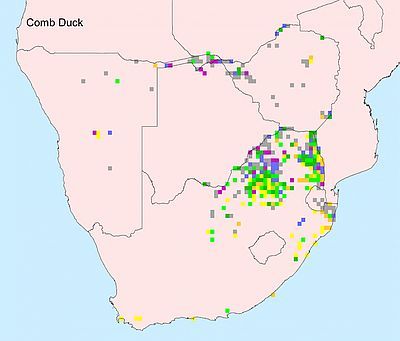
Habitat
Wetlands, freshwater swamps and lakes. Within southern Africa, its distribution basically follows the distribution of mature woodlands because it prefers pans, lakes or rivers bordered by woodland.
Diet
The diet includes small fish, grass seeds, water-lily fruits, leaves and aquatic insects.
Breeding
In good habitats, males are capable of keeping a harem of females, but in poorer habitats, they tend to be monogamous. Males are also sometimes serially polygynous where they form a bond with one female at a time, moving on to the next one once she has laid the eggs. Usually nest in a cavity of a tree, 4-12 m above the ground, but also known to nest on old Hamerkop nests. The nest is usually near water but can be up to 2 km away. Females compete for nest sites, resorting to fighting one another if necessary. The nest is a rough structure built from twigs and course grass, and is lined with grass, leaves and feathers. Breeding season is from September to April. The female usually lays 8-11 eggs (probably one egg per day) and on completion of the clutch, incubates them for 28-30 days before they hatch. Clutches of up to 20 are probably due to more than one female laying in the nest. When the female leaves the nest to feed, she covers the eggs with down, which keeps them warm. Ducklings have very sharp claws and are able to climb vertical wooden surfaces. They jump from the nest when the female calls them from below the nest. Only the female looks after the young although the male is in the vicinity to drive off intruding males. By 65-70 days, the young have fully developed flight feathers.
Call
Various harsh froglike guk-guk calls by female and hisses by male.
Listen to Bird Call.
Status
Mainly a summer visitor; nomadic.
Order: Anseriformes. Family: Anatidae
Description
Size 64-79 cm. The duck gets its common name from the large, fleshy, dark grey ‘comb’ on the top of the male’s black beak, which enlarges during the breeding season. Males have glossy blue-black or green-black upperparts, tail and wings, white underparts and pale grey or black flanks. The top of the head and back of the neck are black, and the rest of the head is white, speckled black, with yellow tinges on the sides and on the neck during the breeding season. Narrow black bands run along the sides of the upper breast. The Comb Duck’s legs and feet are dark grey, and the eyes dark brown.
Females are much smaller than males, with less glossy plumage, less well-defined black breast bands, more speckling on the head, which lacks any yellowish tinge, and sometimes with brownish mottling on the underparts. Females also lack the ‘comb’ and have a grey bill.
Juveniles are brownish, with a dark eye-stripe, and attain adult plumage in the second year.
Taxonomy
Initially, it was placed in the dabbling duck subfamily Anatinae. Later, it was assigned to the “perching ducks”, a paraphyletic assemblage of waterfowl most of which are intermediate between dabbling ducks and shelducks. As the “perching ducks” were split up, the knob-billed duck was moved to the Tadorninae or shelduck subfamily. Most taxonomic authorities split this species and the South American Comb duck (Sarkidiornis sylvicola) from each other. The official name is again "Knbo-billed Duck". Knob-billed ducks are generally larger in size when compared to Comb ducks, and flanks are usually lighter (light grey, in females sometimes whitish).
Distribution
Has a wide distribution covering southern Asia (Pakistan to Southern China) and sub-Saharan Africa. Widespread within Sub-Saharan Africa but absent from semi-arid and arid regions. In parts of Africa, Knob-billed ducks are partially migratory, undertaking sometimes extensive seasonal journeys in response to dry season water availability.

Habitat
Wetlands, freshwater swamps and lakes. Within southern Africa, its distribution basically follows the distribution of mature woodlands because it prefers pans, lakes or rivers bordered by woodland.
Diet
The diet includes small fish, grass seeds, water-lily fruits, leaves and aquatic insects.
Breeding
In good habitats, males are capable of keeping a harem of females, but in poorer habitats, they tend to be monogamous. Males are also sometimes serially polygynous where they form a bond with one female at a time, moving on to the next one once she has laid the eggs. Usually nest in a cavity of a tree, 4-12 m above the ground, but also known to nest on old Hamerkop nests. The nest is usually near water but can be up to 2 km away. Females compete for nest sites, resorting to fighting one another if necessary. The nest is a rough structure built from twigs and course grass, and is lined with grass, leaves and feathers. Breeding season is from September to April. The female usually lays 8-11 eggs (probably one egg per day) and on completion of the clutch, incubates them for 28-30 days before they hatch. Clutches of up to 20 are probably due to more than one female laying in the nest. When the female leaves the nest to feed, she covers the eggs with down, which keeps them warm. Ducklings have very sharp claws and are able to climb vertical wooden surfaces. They jump from the nest when the female calls them from below the nest. Only the female looks after the young although the male is in the vicinity to drive off intruding males. By 65-70 days, the young have fully developed flight feathers.
Call
Various harsh froglike guk-guk calls by female and hisses by male.
Listen to Bird Call.
Status
Mainly a summer visitor; nomadic.
Knob-billed Duck Photos
115. Knob-billed Duck Sarkidiornis melanotos
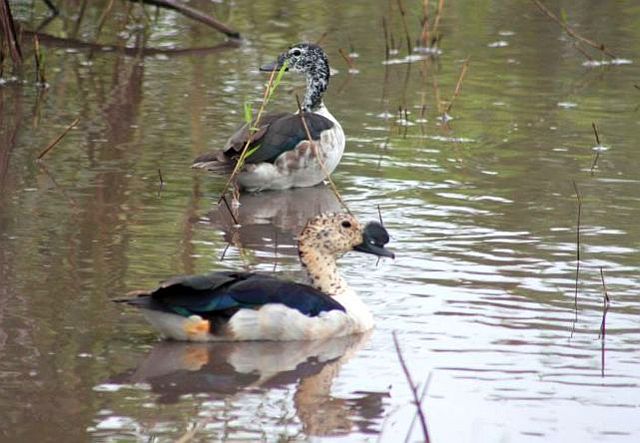 © harrys
© harrys
Female & Male, Kruger National Park
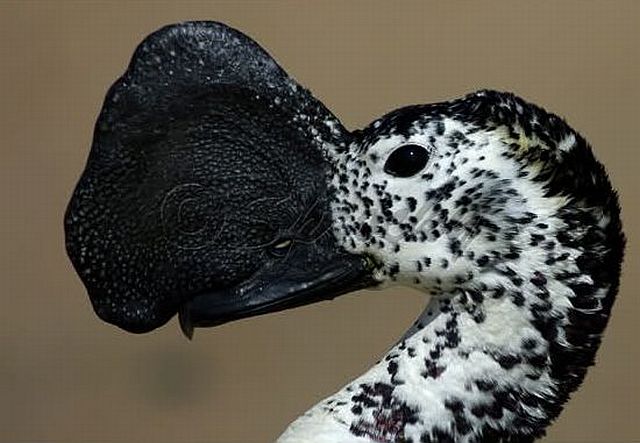 © Sprocky
© Sprocky
Male
 © lowveldboy
© lowveldboy
Male
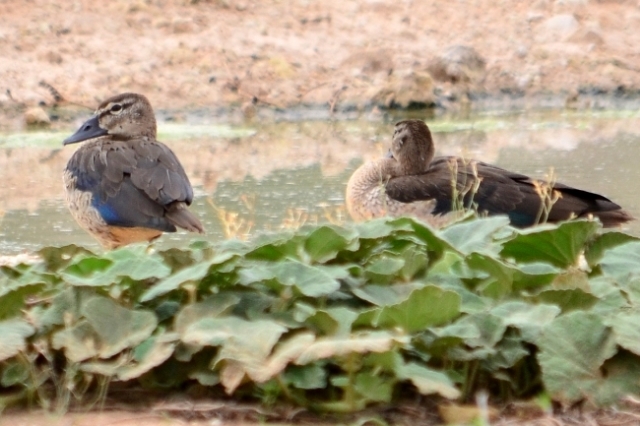 © Mel
© Mel
Juveniles. Kamfersboom, Kgalagadi Transfrontier Park
Links:
Species text Sabap1
Sabap2
Sasol
 © harrys
© harrysFemale & Male, Kruger National Park
 © Sprocky
© SprockyMale
 © lowveldboy
© lowveldboyMale
 © Mel
© MelJuveniles. Kamfersboom, Kgalagadi Transfrontier Park
Links:
Species text Sabap1
Sabap2
Sasol
- Sprocky
- Posts: 7110
- Joined: Sat May 19, 2012 12:29 pm
- Country: South Africa
- Location: Grietjie Private Reserve
- Contact:
Egyptian Goose
102. Egyptian Goose Alopochen aegyptiacus
Order: Anseriformes. Family: Anatidae
Description
The Egyptian goose is a large bird with a length of around 68 cm and the sexes are alike in plumage colouration, although the males are slightly bigger and have a thicker neck than the females. With an overall brown colour, they have rufous eye patches set in a lighter coloured face, and have lighter coloured under parts with a brown patch on breast. The vent is white and the speculum is green. Legs and feet are pink; bill is pink; eyes are orange.
Juvenile lacks eye and breast patches, and the forewing panel is grey, not white.
Distribution
Througout southern Africa.
Habitat
Most inland waters, estuaries and cultivated fields.
Diet: Mainly vegetable matter, especially grass shoots, rhizomes and tubers.
Breeding
Forms strong pair bond and highly territorial. Nest is made by the female and is a shallow bowl of grass, reeds, leaves and down. The most usual nest site is on the ground and in these circumstances the female first scrapes a shallow hollow in the ground before constructing the rest of the nest with plant material and down. Egg-laying season is year-round, peaking from May to December. The female lays 5-11 creamy white eggs eggs, she incubates them for 28-30 days before they hatch.
Call
The call of the male and female Egyptian goose are distinctly different, and their vocalizations provide one of the most reliable ways to differentiate between the sexes. The male typically gives a rather hoarse hiss, while the female is much more vocal and utters a loud honking hur-hur-hur.
Listen to Bird Call.
Status
Very common resident with widespread movements.
Order: Anseriformes. Family: Anatidae
Description
The Egyptian goose is a large bird with a length of around 68 cm and the sexes are alike in plumage colouration, although the males are slightly bigger and have a thicker neck than the females. With an overall brown colour, they have rufous eye patches set in a lighter coloured face, and have lighter coloured under parts with a brown patch on breast. The vent is white and the speculum is green. Legs and feet are pink; bill is pink; eyes are orange.
Juvenile lacks eye and breast patches, and the forewing panel is grey, not white.
Distribution
Througout southern Africa.
Habitat
Most inland waters, estuaries and cultivated fields.
Diet: Mainly vegetable matter, especially grass shoots, rhizomes and tubers.
Breeding
Forms strong pair bond and highly territorial. Nest is made by the female and is a shallow bowl of grass, reeds, leaves and down. The most usual nest site is on the ground and in these circumstances the female first scrapes a shallow hollow in the ground before constructing the rest of the nest with plant material and down. Egg-laying season is year-round, peaking from May to December. The female lays 5-11 creamy white eggs eggs, she incubates them for 28-30 days before they hatch.
Call
The call of the male and female Egyptian goose are distinctly different, and their vocalizations provide one of the most reliable ways to differentiate between the sexes. The male typically gives a rather hoarse hiss, while the female is much more vocal and utters a loud honking hur-hur-hur.
Listen to Bird Call.
Status
Very common resident with widespread movements.
- Sprocky
- Posts: 7110
- Joined: Sat May 19, 2012 12:29 pm
- Country: South Africa
- Location: Grietjie Private Reserve
- Contact:
Egyptian Goose Photos
102. Egyptian Goose Alopochen aegyptiacus
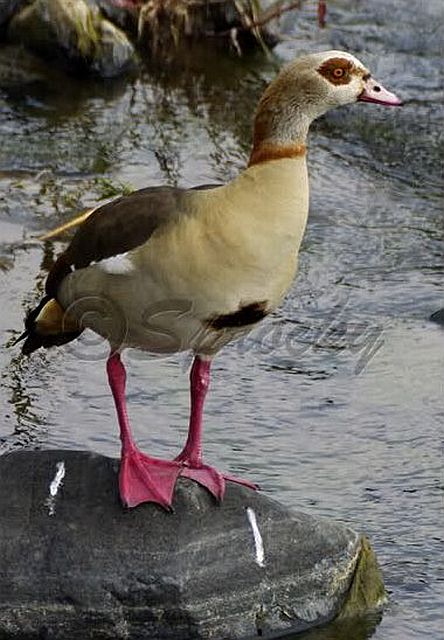
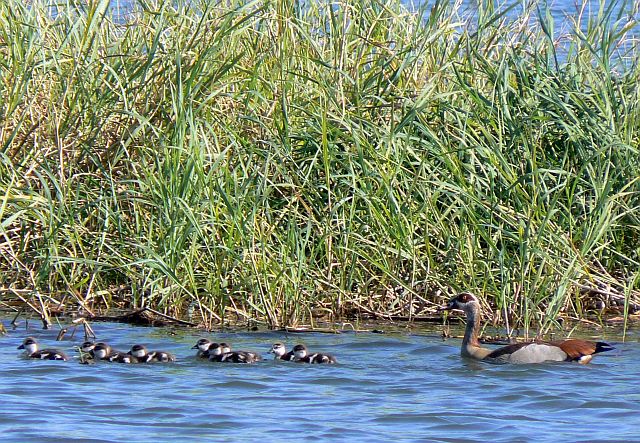 © Toko
© Toko
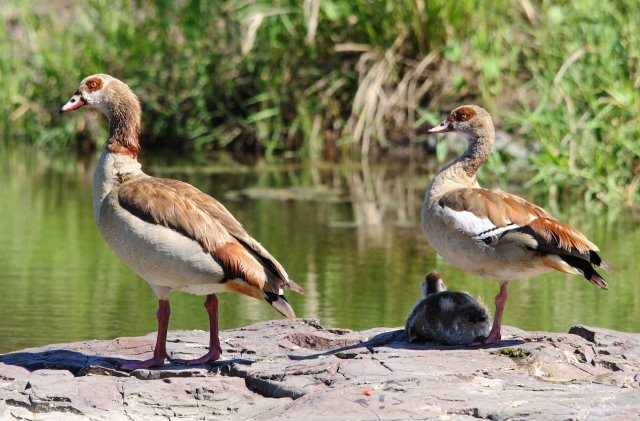 © Flutterby
© Flutterby
Male, female & chick
 © leachy
© leachy
 © Flutterby
© Flutterby
Links:
Species text Sabap1
Sabap2
Sasol
Africa Wild Bird of the Month: Egyptian Goose: https://africawild-forum.com/viewtopic.php?f=168&t=1784

 © Toko
© Toko © Flutterby
© FlutterbyMale, female & chick
 © leachy
© leachy © Flutterby
© FlutterbyLinks:
Species text Sabap1
Sabap2
Sasol
Africa Wild Bird of the Month: Egyptian Goose: https://africawild-forum.com/viewtopic.php?f=168&t=1784


